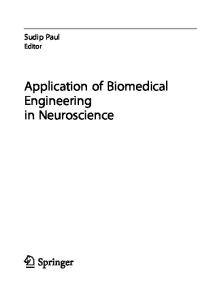Selective laser sintering and its application in biomedical engineering
- PDF / 653,156 Bytes
- 8 Pages / 585 x 783 pts Page_size
- 92 Downloads / 398 Views
Introduction As a designed manufacturing technology, solid free-form fabrication (SFF) or rapid prototyping (RP) has drastically improved our ability to fabricate objects with customized designs, complex geometries, precise dimensions, and controllable architecture. In fact, RP is a group of techniques that can generate a physical model directly from computer-aided design (CAD) data in a layer-by-layer manner, where each layer is the shape of the cross-section of the model at a specific level.1 In applying RP techniques in biomedical engineering, the data used to design and fabricate objects are usually based on data from CADs, computer-based medical imaging technologies such as magnetic resonance imaging (MRI) and computer tomography (CT), or other computer-based technologies.2 Computer-based data are converted to an STL file format (which is a standard format for RP techniques), STL being derived from “stereolithography,” the oldest RP technology. The computer-generated two-dimensional layers are then assembled, and a concrete model is created, starting from the bottom and proceeding upward. In production, each layer is bonded to the previous layer, producing a solid object based on the design. Based on their working principles, RP techniques can be divided into several categories: laser polymerization-based techniques, such as stereolithography apparatus and two-photon polymerization; nozzle deposition-based techniques, such as fused deposition modeling and three-dimensional (3D) plotting;
and powder-based techniques, such as 3D printing (3DP) and selective laser sintering (SLS).3,4 Generally, each technique is suitable for a specific material (or group of materials) or a specific form of the material and has its own advantages and disadvantages. Two decades ago, tissue engineering emerged as a promising alternative to using autografts, the gold standard in current surgery, and allografts for tissue repair and regeneration. There are several strategies in tissue engineering, including cell-based tissue engineering, factor-based tissue engineering and scaffold-based engineering. For cell-based tissue engineering, autologous or allogeneic cells are first isolated and then injected in single cell suspensions at the targeted sites of patients, or they can be manipulated by cell assembly into multicellular spheroids or cell sheets for transplantation in patients. Factor-based tissue engineering is conducted by the injection of biomolecules (normally in a carrier), such as growth and differentiation factors, or genes to targeted locations in patients. For scaffold-based tissue engineering, cells and/or biomolecules are encapsulated within the matrices or seeded onto the surface of three-dimensional (3D) scaffolds for tissue regeneration.4 The scaffolds serve as extracellular matrix to direct cell adhesion, proliferation and differentiation and thus promote new tissue formation. With the emergence and development of tissue engineering, various biomaterials and RP techniques are being investigated for fabricating porous sca
Data Loading...











